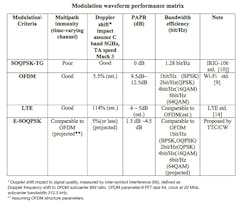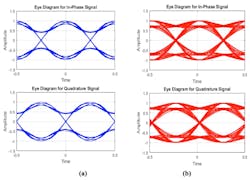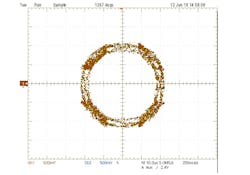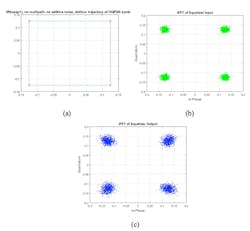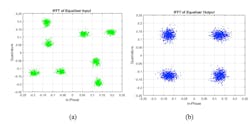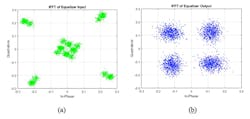E-SOQPSK Modulation Waveforms for Aeronautical Mobile Telemetry Comms
Download this article in PDF format.
What you’ll learn:
- E-SOQPSK is an OFDM-structured, single-carrier modulation waveform, configurable to include OQPSK, SOQPSK, or m-QAM.
- Preliminary lab results confirmed its low peak-to-average power ratio (PAPR) and high spectrum efficiency.
- Preliminary simulations demonstrated multipath resilience of an E-SOQPSK waveform by utilizing OFDM structure-based frequency-domain equalization at the receiver.
Curtiss-Wright’s E-SOQPSK (Extensible SOQPSK) is a software-configurable, ultra-low-power Wi-Fi modulation scheme. Its waveforms offer some beneficial performance attributes for aeronautical telemetry communication applications, namely:
- A robust communication link in a channel with time-varying multipath and highly dynamic Doppler shift
- High transmit-power efficiency
- High bandwidth efficiency
Channel Impairments and Existing Solutions
Multipath
Since the introduction of multi-carrier (MC) orthogonal frequency-division multiplexing (OFDM) in 1966 by Chang, Bell Laboratory,1,2 the MC modulation waveform has demonstrated its robust link performance with high modulation bandwidth efficiency in wireless-communication applications. They include today’s Wi-Fi and Long-Term Evolution (LTE) technology.
Traditional single-carrier (SC) modulation-based wireless systems, such as quadrature amplitude modulation (QAM), shaped-offset quadrature phase-shift keying (SOQPSK), and the like, have shown a higher transmitter power efficiency when compared to OFDM-based systems (Fig. 1), while having a comparably good modulation bandwidth efficiency. However, it’s known that the link quality of a SC-based system such as SOQPSK-TG (Telemetry Group) deteriorates noticeably in a wireless channel with multipath, especially in time-varying multipath channels.3,4
Over decades of research efforts, various channel-equalization algorithms for QAM and other SC modulations have been proposed and utilized. For example, frequency-domain adaptive equalization algorithms were proposed and experimented on.5
Sparse adaptive-channel equalization algorithms were invented to combat wireless link degradation in terrestrial multipath environments,6 as was sparse equalization of SOQPSK-TG for aeronautical telemetry applications.7 Those equalization algorithms have mostly been in the experimental stage, not being widely implemented in wireless-communication applications for their limited capacity to deal with rapidly time-varying wireless channels.
For example, it may occur in an aeronautical telemetry communications link when a test article (TA, i.e., an aircraft serving as a test platform) is flying at low altitudes, or during take-off, landing, or taxiing. These typical time-varying multipath cases remain a major challenge for link integrity in aeronautical telemetry wireless communications.
Doppler shift
LTE technology has drawn attention in aeronautical telemetry applications for its multipath immunity and flexible network connectivity. However, LTE’s inability to handle high Doppler shifts is among the major reasons why commercial off-the-shelf (COTS) LTE transceivers can’t be used in aeronautical telemetry applications.8
Some methods have been studied and/or proposed to estimate and/or compensate Doppler shift. One example involves a delay-response method to reduce a high Doppler shift to a manageable level for the subcarriers in commercial LTE equipment. This compensation for Doppler shift requires a round-trip time delay between the ground station (GS) and TA.8 The performance of this scheme may be limited by its long-elapsed time for frequency estimation/compensation, especially in the case of unpredictable time-varying high Doppler shift, which would be induced, for example, by a rapid maneuver of the TA.
Transmitter power efficiency
One of the key factors affecting transmit power efficiency is the peak-to-average power ratio (PAPR) of the transmit waveform. OFDM9 systems have a lower transmit power efficiency when compared to constant-envelope modulation schemes such as SOQPSK-TG due to their high PAPR. The PAPR of OFDM signal waveforms can be as high as 9 to 12 dB as opposed to 0 dB for SOQPSK-TG.10
Transmission bandwidth efficiency
OFDM and SC QAM modulations have similar bandwidth efficiency. For example:
SOQPSK-TG: 1.28 bits/Hz [1-e], m-QAM: m bits/Hz (m = 2k; k= 2, 3, 4…)3
OFDM: 1 bit/Hz (BPSK, OQPSK), 2 bits/Hz (QPSK), 4 bits/Hz (16QAM), 6 bits/Hz (64QAM)9
A Proposed E-SOQPSK Modulation Waveform
To utilize both the multipath resistance capability offered by an OFDM-modulated waveform and the high transmitter-power efficiency of SOQPSK-TG modulation, Curtiss-Wright proposes a scheme of adaptive coding with hybrid SOQPSK/OFDM modulations for the Telemetry Network Standard (TnMS).11
Over the past decade, Teletronics Technology Corp. (now Teletronics, a Curtiss-Wright company) has developed and delivered an OFDM-modulation-based IP transceiver (nXCVR-2000)12,13 and an SOQPSK-TG modulation IP transceiver (nXCVR-3140) to the telemetry industry for aeronautical wireless-link communications. Based on first-hand field test results and performance assessment on modulation algorithms utilized in the nXCVR series transceiver products, the company proposes high-performance E-SOQPSK, an OFDM-structured and flexible single-carrier modulation scheme.
How E-SOQPSK Works
The core of E-SOQPSK modulation (Fig. 2) is an OFDM-structured, extensible, single-carrier SOQPSK waveform. This combination of OFDM and SOQPSK provides advantages of both multiple- and single-carrier modulation waveforms. It also helps improve the performance in a dynamic time-varying multipath and rapid Doppler shift environment, while maintaining a low PAPR and high transmitter power efficiency.
E-SOQPSK is a single-carrier modulation waveform, a deviation of the traditional OFDM, LTE (uplink) waveforms scheme. E-SOQPSK can be configured to present a BPSK, OQPSK, m-QAM, or constant-envelope (CE) SOQPSK-modulation waveform.
A performance comparison of E-SOQPSK with OFDM,9 SOQPSK-TG,10 and LTE (UL)14 is shown in the table.8,15
Preliminary Results
Characteristics of E-SOQPSK modulation signal
This section shows certain characteristics of the E-SOQPSK modulation waveforms in comparison with a standard SOQPSK-TG waveform. The characteristics of the modulation waveforms were demonstrated in terms of (a) their I-Q component eye diagrams of the modulation waveform; (b) the signal power spectrum, (c) the signal’s PAPR, and (d) the I-Q trajectory of the signal waveform.
The results show that:
- E-SOPQK has similar characteristics of its baseband waveform time-domain transition to standard SOQPSK-TG, as illustrated in an eye diagram (Fig. 3, obtained by MATLAB simulation; and Fig. 6, obtained by laboratory test).
- E-SOQPSK has a tighter spectrum spread to compare with SOQPSK-TG waveform (Fig. 4. obtained by laboratory test)
- Confirmation of a PAPR of near 1 dB for E-SOQPSK both in OQPSK and SOQPSK waveform modes. The results (obtained by laboratory test) are in Figures 5 and 6, respectively.
E-SOQPSK frequency-domain equalization
The results shown in this section are from the MATLAB simulation. Figure 7 provides a block diagram of the E-SOQPSK simulation model used to demonstrate performance of an E-SOQPSK frequency-domain equalizer.
The proposed E-SOQPSK transmitter is a multimode modulator. It can generate OFDM-structured m-QAM, OQPSK, or SOQPSK modulation waveforms. As shown (Fig. 7, again), an E-SOQPSK modulator in the OQPSK mode generates the waveform, which is fed to a two-ray multipath channel and then processed by an E-SOQPSK demodulator, including frequency-domain equalization.
Through MATLAB simulations in which we set various multipath parameters, we illustrate a potential capability of the OFDM-structured frequency-domain equalization. This test shows simulation results of complex signal I-Q constellation of the equalizer output vs. its input under a two-ray channel model with different channel-model parameters, such as reflector phase rotation (theta), channel time delay (dL), and attenuation factor (rho) of the second path, as well as additive noise. The results are revealed in Figures 8, 9, and 10.
Figure 10 depicts the equalizer input vs. its output. The channel that’s set for this simulation is a severe multipath condition (90% of reflection signal in strength was delayed and rotated in phase, then added on the signal on direct path). The corresponding signal spectrum at the receiver output can be seen in Figure 11, which shows signal strength dips of up to 25.6 dB.
Conclusion
In this article, we’ve proposed E-SOQPSK, a software configurable ultra-low-power Wi-Fi modulation scheme for aeronautical telemetry communication applications that’s configurable to SOQPSK, OQPSK, or QAM. The embedded OFDM structure of the E-SOQPSK modulation waveform can be utilized by an E-SOQPSK receiver to improve its frequency-domain equalization performance in a time-varying multipath and high Doppler-shift environment.
Preliminary laboratory results confirm that E-SOQPSK modulation waveform has a near 1-dB PAPR, close to that of a traditional SOQPSK-TG modulated waveform. They also show that the E-SOQPSK-modulated waveform has a similar eye-diagram pattern to that of a standard SOQPSK-TG waveform.
Preliminary simulation results illustrate that an E-SOQPSK modulation waveform can provide robust performance in a heavy multipath, time-varying channel as expected, benefitting from the fast frequency-domain equalization techniques enabled by its OFDM structure.
Future Work
Further work in terms of full system simulations and refinement of the demodulation process, especially channel-equalization algorithms with various Doppler and multipath cases, as well as transmitter and receiver prototype development, is needed to evaluate the performance and verify the proposed advantages of the E-SOQPSK waveforms.
References
1. R. W. Chang, "Synthesis of Band-Limited Orthogonal Signals for Multichannel Data Transmission," Bell System Technical Journal, vol. 45, no. 10, pp. 1775-1796, 1966.
2. N. LaSorte, W. J. Barnes, and H. H. Refai, "The History of Orthogonal Frequency Division Multiplexing," in Proceedings of the Global Communications Conference, 2008.
3. J. G. Praokis, Digital Communications, 4th ed., McGraw-Hill, 2000.
4. T. S. Rappaport, Wireless Communications: Principles and Practice, 2nd ed., Upper Saddle River, NJ: Prentice Hall, 2002.
5. F. Pancaldi, G. M. Vitetta, R. Kalbasi, N. Al-Dhahir, M. Uysal, and H. Mheidat, "Single-Carrier Frequency Domain Equalization," IEEE Signal Processing Magazine, no. September, pp. 37-56, 2008.
6. C. Y. Lu, "Sparse Equalization Filter Adaptive In Two Dimensions." United States of America Patent 5,777,910, 7 July 1998.
7. M.S. Afran, M. Saquib, and M. Rice, "SPARSE MMSE EQUALIZER FOR GTR-STBC IN AERONAUTICAL TELEMETRY," in Proceedings of the International Telemetering Conference, Las Vegas, 2017.
8. E. Fung, W.H. Johnson, A. Kogiantis, and K.M. Rage, "Doppler Estimation and Compensation for LTE-Based Aeronautical Mobile Telemetry," in International Telemetering Conference, 2018.
9. 802.11-2016, "IEEE Standard for Information technology—Telecommunications and information exchange between systems Local and metropolitan area networks—Specific requirements - Part 11: Wireless LAN Medium Access Control (MAC) and Physical Layer (PHY) Sp," 2016.
10. Range Commanders Council Telemetry Group, "IRIG STANDARD 106-17: TELEMETRY STANDARDS," Secretariat Range Commanders Council, US Army White Sands Missile Range, 2017.
11. E. D. Wang, T. J. Brothers, and R. T. Causey, "Link Quality Metrics for Adaptive Coding and Modulation With SOQPSK And OFDM," in International Telemetering Conference Proceedings, 2017.
12. C. Lu, P. Cook, J. Hildin, and J. Roach, "The Design of a High-Performance Network Transceiver for iNET," in International Telemetering Conference Proceedings, 2008.
13. C. Lu and J. Roach, "The Performance Evaluation of an OFDM-Based iNET Transceiver," in International Telemetering Conference Proceedings, 2009.
14. C. Johnson, Long Term Evolution in BULLETS, 2nd ed., CreateSpace, 2012.
15. G. Berardinelli, L. Á. M. Ruiz De TEMIÑO, S. Frattasi, M. I. Rahman, and P. Mogensen, "OFDMA VS. SC-FDMA: PERFORMANCE COMPARISON IN LOCAL AREA IMT-A SCENARIOS," IEEE Wireless Communications, pp. 64-72, October 2008.
About the Author
Dr. Cheng Y. Lu
Chief Communications System Engineer
Dr. Lu has over 35 years of experience in digital communication system and DSP design;. He's the design lead in advanced high-speed digital communications modem (PHY), transceiver, wireless communication systems. Experience in major industrial companies includes TTC/Curtiss-Wright (Newtown, Pa.), Centillium Communications (Fremont, Calif.), Sarnoff Corp. (Princeton, N.J.), Mitsubishi Research (Princeton, N.J.), Panasonic Communication Research (Princeton, N.J.); Thomson Multimedia (Indianapolis, Ind.).
Dr. Lu has seven U.S./international patents(granted), three patent applications in pending, and 26 technical paper publications. In TTC/Curtiss-Wright, he's the lead in OFDM based transceiver (PHY) design, iNET SOQPSK transceiver (PHY) design, and long-range wireless transmitter, receivers. Technical focus includes advanced digital modulations, FEC (forward error correction) techniques, signal synchronization, channel equalization, MIMO algorithms, channel estimations, digital filter/estimation techniques, and DSP implementation in high-performance FPGA, ASIC, and DSP processors. Besides PHY layer design, his technical interests also include network cross-layer optimization in communications systems.



